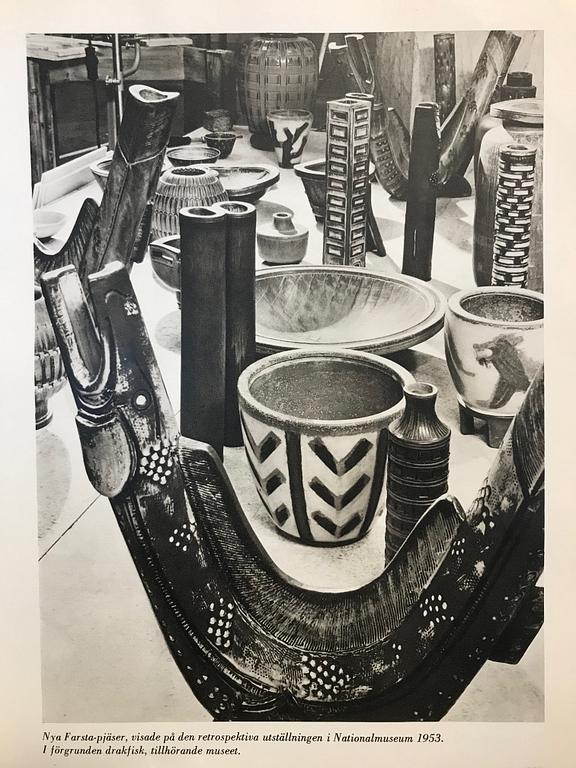Wilhelm Kåge
a "Farsta" stoneware sculpture of a 'dragon fish', Gustavsberg studio, Sweden 1950's.
Turquoise blue glaze, the fens with studio stamps, FARSTA and signed KÅGE. Height ca 49 cm, length ca 56 cm, width 21,5 cm.
Firing cracks to interior.
Literature
Nils Palmgren, "Wilhelm Kåge konstnär och hantverkare" Nordisk Rotogravyr, Stockholm 1953. Compare the dragon fish sculptures, "Nya Farsta-pjäser", illustrated from an exhibition at the National museum in Stockholm 1953, p 223.
Gisela Eronn, "Wilhelm Kåge - Keramikens mästare", Prisma 2006, see this dragon fish illustrated p 93.
More information
After the year 1949, when Stig Lindberg took over Kåge's role as Gustavsberg's artistic leader, Kåge finally got the possibility to develop as a ceramic artist. In 1953, Kåge was invited by the National Museum to show his artistic work at a large retrospective and critically acclaimed exhibition. Among the "new Farsta pieces", Kåge exhibited a number of large u-shaped sculptures, so-called "dragon fishes".
Designer
Wilhelm Kåge was a Swedish artist and ceramicist. Kåge is known for his ceramics for the Gustavsberg porcelain factory, where he was the artistic director from 1917 to 1949. Kåge studied from 1910 under Carl Wilhelmson at the Valand Academy of Art in Gothenburg and later under Johan Rohde in Copenhagen, where he became acquainted with Gösta Adrian-Nilsson (GAN) and grew closer to modern art. He studied graphic art in Munich and began his artistic career by designing posters for theatres and exhibitions, among other things. His connection with Gustavsberg was facilitated through the Swedish Society of Crafts and Design, as Gustavsberg needed new products for the Home Exhibition at Liljevalchs in 1917. He went on to design around thirty different dinnerware sets, as well as art pottery, colourful faience, stoneware, and various series of art pottery such as Carrara, Surrea, and Våga. In 1942, Kåge, together with Stig Lindberg, established the Gustavsberg Studio, which became a kind of aesthetic laboratory for art pottery.
At the Stockholm Exhibition in 1930, Kåge presented Gustavsberg's future sales success "Argenta," a series of art pottery primarily glazed in green but also in red, blue, brown, and celadon green, and decorated with various silver designs based on Kåge's sketches. Argenta became very popular and was produced well into the 1970s. The powerful stonewares "Farsta" were also presented at the Stockholm Exhibition and they became the ones closest to Kåge's heart and with which he continued to experiment throughout his life. The pieces improved over the years, and the most impressive and many of the most sought-after items were created by Kåge during the 1950s.




































































